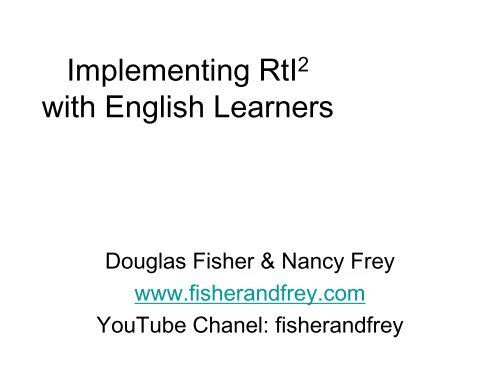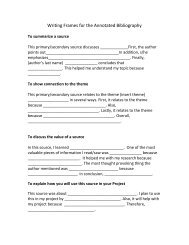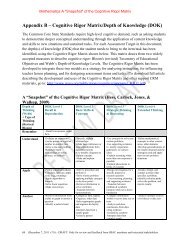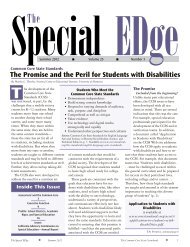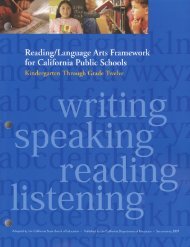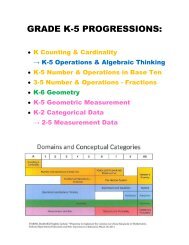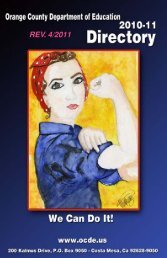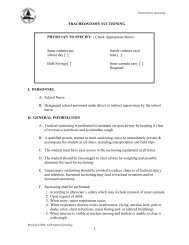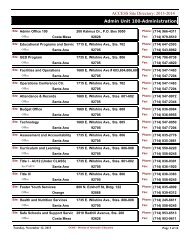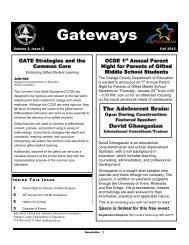RtI2 - Implementing RtI with ELs - Doug Fisher
RtI2 - Implementing RtI with ELs - Doug Fisher
RtI2 - Implementing RtI with ELs - Doug Fisher
Create successful ePaper yourself
Turn your PDF publications into a flip-book with our unique Google optimized e-Paper software.
<strong>Implementing</strong> <strong>RtI</strong> 2<br />
<strong>with</strong> English Learners<br />
<strong>Doug</strong>las <strong>Fisher</strong> & Nancy Frey<br />
www.fisherandfrey.com<br />
YouTube Chanel: fisherandfrey
Traditional View of Learning<br />
When time and instruction are held constant…<br />
LEARNING<br />
Adapted from Buffum, Mattos, & Weber, 2009<br />
… learning outcomes<br />
vary.
A New View of Learning<br />
When time and instruction are variable…<br />
LEARNING<br />
… learning is<br />
held constant.<br />
Adapted from Buffum, Mattos, & Weber, 2009
Purpose of <strong>RtI</strong><br />
An alternative way<br />
to identify students<br />
as having learning<br />
disabilities, making<br />
sure that students<br />
who struggle were<br />
not misidentified as<br />
disabled when<br />
different and/or<br />
more intensive<br />
instruction<br />
addressed their<br />
needs.
Purpose of <strong>RtI</strong><br />
An alternative way<br />
to identify students<br />
as having learning<br />
disabilities, making<br />
sure that students<br />
who struggle were<br />
not misidentified as<br />
disabled when<br />
different and/or<br />
more intensive<br />
instruction<br />
addressed their<br />
needs.
A school<br />
improvement<br />
process designed<br />
to ensure that<br />
students receive<br />
the instruction,<br />
intervention, and<br />
support<br />
necessary to be<br />
successful.
A school<br />
improvement<br />
process designed<br />
to ensure that<br />
students receive<br />
the instruction,<br />
intervention, and<br />
support<br />
necessary to be<br />
successful.
Response to Instruction<br />
and Intervention (<strong>RtI</strong> 2 )<br />
• Tier 1: Quality core instruction<br />
• Tier 2: Supplemental intervention<br />
• Tier 3: Intensive intervention<br />
Tier 1:<br />
70+%<br />
Tier 2:<br />
20-30%<br />
Tier 3:<br />
5-15%<br />
Manipulate variables…
Tier 1: Quality Core Instruction<br />
for English Language<br />
Learners<br />
• Based on a Gradual Release of Responsibility<br />
• Formative assessments (feed-forward not just<br />
feedback)<br />
• Productive Group Work<br />
• Small Group Instruction<br />
• Focus on Language
TEACHER RESPONSIBILITY<br />
Focus Lesson<br />
Guided<br />
Instruction<br />
“I do it”<br />
“We do it”<br />
Collaborative<br />
Independent<br />
“You do it<br />
together”<br />
“You do it<br />
alone”<br />
STUDENT RESPONSIBILITY<br />
A Structure for Instruction that Works
The established purpose<br />
focuses on<br />
student<br />
learning,<br />
rather than an<br />
activity, task, or<br />
assignment.
Quality Indicator #1<br />
Complexity of Task: The task is a<br />
novel application of a grade-level<br />
appropriate concept and is<br />
designed so that the outcome is not<br />
guaranteed (a chance for productive<br />
failure exists).
Quality Indicator #2<br />
Joint attention to tasks or materials<br />
Students are interacting <strong>with</strong> one another<br />
to build each other’s knowledge. Outward<br />
indicators include body language and<br />
movement associated <strong>with</strong> meaningful<br />
conversations, and shared visual gaze<br />
on materials.
Quality Indicator #3<br />
Argumentation not arguing:<br />
Student use accountable talk to<br />
persuade, provide evidence, ask<br />
questions of one another, and disagree<br />
<strong>with</strong>out being disagreeable.
Quality Indicator #4<br />
Language support: Written,<br />
verbal, teacher, and peer supports<br />
are available to boost academic<br />
language usage.
Quality Indicator #5<br />
Grouping: Small groups of 2-5<br />
students are purposefully<br />
constructed to maximize individual<br />
strengths <strong>with</strong>out magnifying areas of<br />
needs (heterogeneous grouping).
Quality Indicator #6<br />
Teacher role: What is the teacher<br />
doing while productive group work is<br />
occurring?
Tiers 2 and 3 intervention are not a<br />
Band-Aid…<br />
…for ineffective Tier 1 instruction.
The Role of<br />
Assessment<br />
in <strong>RtI</strong> 2
Screening Tools<br />
Progress Monitoring<br />
Program Evaluation
DIBELS<br />
Oral fluency<br />
SAM<br />
SALLI<br />
Writing sample<br />
Spelling inventory<br />
Screening Tools
Which do you<br />
use?<br />
Are they<br />
working for<br />
you?
Curriculum-based<br />
measures (CBM):<br />
mostly skills-based
Curriculum-based<br />
assessments (CBA):<br />
course curriculum
Both are needed for progress monitoring
Progress<br />
Monitoring<br />
Checklists<br />
Rubrics<br />
Self-assessments<br />
Observations<br />
Competencies
Which do you<br />
use?<br />
Are they<br />
working for<br />
you?
Homework is NOT<br />
a progress monitoring tool!
26%<br />
Number of high school teachers<br />
who“often or very often” run<br />
out of time in<br />
class and assign the content<br />
for homework<br />
(MetLife, 2008)
Traditional homework occurs<br />
too soon<br />
in the instructional cycle.
Cleavers<br />
Slackers<br />
Cheaters<br />
Bewildered
Goals of<br />
Homework<br />
• Fluency building<br />
• Application<br />
• Spiral review<br />
• Extension<br />
<strong>Fisher</strong>, D., & Frey, N. (2008). Homework and the gradual release of responsibility: Making responsibility<br />
possible. English Journal, 98(2), 40-45.
Compare<br />
English language learners to<br />
“true peers”
Suspicion<br />
Disability?<br />
Curriculum causality?<br />
English learner?
Tier 2: Supplemental<br />
• Increase guided instruction <strong>with</strong>in the<br />
school day and beyond the school day<br />
• Small groups (no more than 5)<br />
• Additional language instruction<br />
• Preview/review<br />
• Recruit additional staff members to provide<br />
supplemental instruction<br />
• Increase progress monitoring and<br />
assessment
Who provides Tier 2?<br />
• Mostly classroom<br />
teachers as students<br />
work productively<br />
• Push-in staff (15%<br />
rule)
The focus of the monitoring team
Manipulate<br />
the variables
Access to<br />
Expertise
Time and Duration
Group size
Assessments<br />
& Screening tools
CBMs 1-2 times per month<br />
for progress monitoring
Academic Recovery and<br />
After school tutorials
Involve the family
Increased guided instruction<br />
<strong>with</strong> smaller groups
Zone of Proximal<br />
Development<br />
Scaffolding
“As easy as learning<br />
to ride a bike”
Scaffolds in Classroom<br />
Instruction<br />
• Robust questions to check for<br />
understanding<br />
• Prompts that focus on cognitive<br />
and metacognitive processes<br />
• Cues to shift attention to sources<br />
• Direct explanation and modeling<br />
to re-teach
Robust Questions to<br />
Check for Understanding
Intention<br />
uncovering,<br />
not testing
Teacher: What is a nocturnal animal?<br />
Student: An animal that stays awake at<br />
night.<br />
Teacher: Good. What is a diurnal<br />
animal?
Teacher: What is a nocturnal animal?<br />
Student: An animal that stays awake<br />
at night.<br />
Teacher: Tell me more about that.<br />
Does a nocturnal animal have<br />
special characteristics?<br />
Student: Well, it doesn’t sleep a lot.
Teacher: What is a nocturnal animal?<br />
Student: An animal that stays awake<br />
at night.<br />
Teacher: Tell me more about that.<br />
Does a nocturnal animal have<br />
special characteristics?<br />
Student: Well, it doesn’t sleep a lot.
Prompting for Cognitive and<br />
Metacognitive Thinking
Prompts<br />
So the student does the<br />
cognitive work
Background<br />
knowledge<br />
prompts<br />
invite students to<br />
use what they know<br />
to resolve problems
Process or<br />
Procedure<br />
Prompts<br />
To perform a<br />
specific task
Reflective<br />
prompt<br />
knowing about knowing<br />
“What are we learning today?”
Heuristic<br />
prompt<br />
Informal and<br />
less defined<br />
“Make a graph so you can see it.”
How do you<br />
find parking?
Teacher: What is a nocturnal animal?<br />
Student: An animal that stays awake at night.<br />
Teacher: Tell me more about that. Does a nocturnal<br />
animal have special characteristics?<br />
Student: Well, it doesn’t sleep a lot.<br />
Teacher: I’m thinking of those pictures we saw of the<br />
great horned owl and the slow loris in the daytime<br />
and at night. Does your answer still work?
Cues to Shift Attention
Cues<br />
Shift attention to<br />
sources of<br />
information<br />
More direct and specific than prompts
the expert commentator sees<br />
things you don’t<br />
cues do the same for novices<br />
Attention grows <strong>with</strong> competence
Visual<br />
Verbal<br />
Gestural<br />
Physical<br />
Positional<br />
Environmental
Using Prompts and<br />
Cues<br />
Context: Students are creating a Jeopardy®-style<br />
game. The teacher is building the background<br />
knowledge of a group of students. He draws their<br />
attention to a sentence in the text: “When you eat<br />
foods—such as bread, meat, and vegetables—<br />
they are not in a form that the body can use as<br />
nourishment.” He asks Mauricio to retell it is his<br />
own words...
Mauricio: So, I think it says that your body can’t use meat like it is meat. It<br />
has to be changed.<br />
Jessica: But that’s what we eat to live. That’s good eating.<br />
Russell: I don’t eat any vegetables. I only like the meat and bread from this,<br />
like a hamburger.<br />
Mr. Jackson: How does that meat change so that your body can use it?<br />
Russell?<br />
Russell: It doesn’t change. It’s meat.<br />
Mr. Jackson: So let’s think about what we know about nourishment and our<br />
food. There’s a process that it goes through, right? [they nod in<br />
agreement] What’s the first step? You know this because you do it<br />
several times a day.<br />
Sarah: The first thing to eat? Is that what you mean?<br />
Mr. Jackson: Yeah, the first thing.<br />
Sarah: You take a bite.<br />
Mr. Jackson: Exactly, right on. So you’ve changed the food, right?<br />
Russell: Yeah, but it’s still meat.<br />
Mr. Jackson: It sure is. But it’s changed a bit, and will change more.<br />
Remember we talked about different kinds of changes. Physical …<br />
Chemical<br />
Russell: So the first thing, when you bite it, it’s a physical change, right?<br />
Mr. Jackson: You know it! And then what happens?
Direct Explanation<br />
and Modeling
When prompting<br />
and cueing fail,<br />
it’s time for<br />
direct<br />
explanation.
Direct Explanation<br />
Identify<br />
Explain<br />
Think aloud<br />
Monitor<br />
Take care not to re-assume responsibility too quickly
Tier 3: Intensive<br />
• Individual<br />
• 30 minutes at least three times per<br />
week<br />
• Increase assessment and monitoring<br />
frequency<br />
• Increase expertise<br />
• A whole school focus
What is “special” about<br />
special education?<br />
• Formalized system of support<br />
(continuing interventions)<br />
• Funding<br />
• Goals and objectives<br />
• Curriculum accommodations and<br />
modifications<br />
• Testing support<br />
• Assistive technology<br />
• Related Services
The Takeaway<br />
• Instruction and Intervention are linked<br />
• Manipulate variables (time, assessment,<br />
expertise, instruction) to intensify<br />
intervention<br />
• Build in a feed forward method so that<br />
<strong>RtI</strong> 2 results inform classroom instruction<br />
and programmatic improvements<br />
• Keep the teacher and family at the<br />
center of communication


